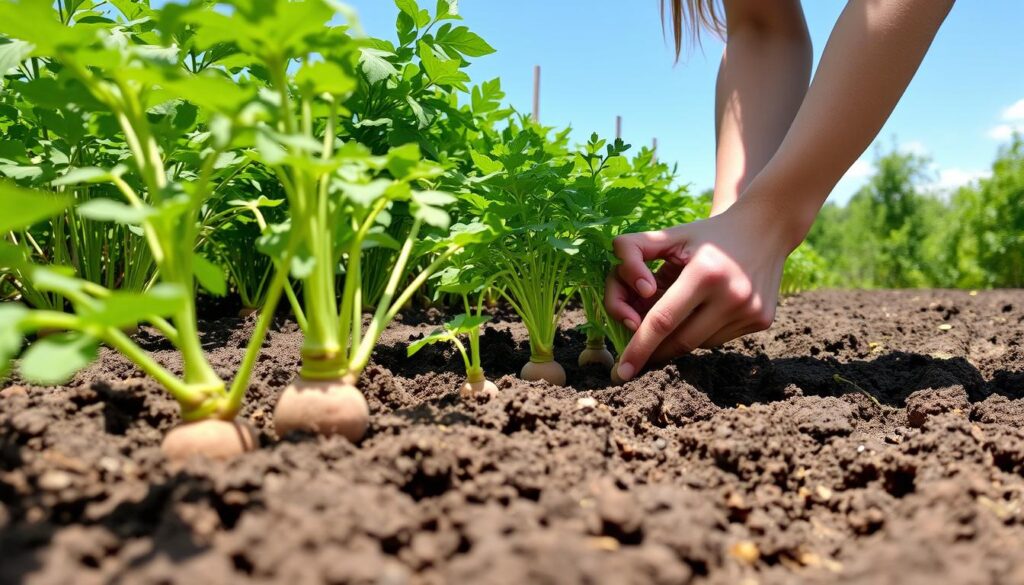Learning to grow sweet potatoes is rewarding. With the right tips, you can have a big harvest. It’s a fun, easy process that needs little equipment and care. This guide will help you grow sweet potatoes, whether you’re new or experienced.
Follow these simple steps and tips to grow tasty sweet potatoes. We’ll cover everything from soil prep to harvesting. Our aim is to give you the knowledge and confidence to grow sweet potatoes at home.
Introduction to Growing Sweet Potatoes
Before we dive into growing sweet potatoes, let’s look at what this tutorial covers. We’ll discuss sweet potato growth, the benefits of growing your own, and what tools and materials you’ll need.
Key Takeaways
- Learn the basics of sweet potato growth and development
- Discover the benefits of growing your own sweet potatoes
- Get the essential tools and materials needed to get started
- Understand how to prepare the soil for sweet potato planting
- Learn how to grow sweet potatoes using simple and effective techniques
- Find out how to care for your sweet potato plants and troubleshoot common issues
Understanding Sweet Potato Basics
Growing sweet potatoes at home starts with knowing the basics. Choosing the right variety is key. With over 400 varieties, picking the best one can be tough. Popular choices include ‘Beauregard’, ‘Covington’, and ‘Jewel’.
Before planting, prepare the soil well. Sweet potatoes need well-draining, loose soil rich in organic matter. The soil pH should be between 5.5 and 6.5. Adding compost or well-rotted manure can help achieve this.
Different Sweet Potato Varieties
- ‘Beauregard’: A popular variety known for its high yields and disease resistance
- ‘Covington’: A variety with a shorter maturity period, making it ideal for cooler climates
- ‘Jewel’: A variety with a sweeter flavor and higher moisture content
Growth Cycle Overview
Sweet potatoes take about 100 to 120 days to mature. They need full sun and warm temperatures. This makes them perfect for summer.
Climate Requirements
Sweet potatoes love warm temperatures between 65°F and 95°F. They can’t handle frost well. So, plant them after the last frost in your area.
Knowing these basics will help you grow tasty sweet potatoes at home. Choose the right variety, prepare the soil well, and ensure the right climate for a great harvest.
Benefits of Growing Your Own Sweet Potatoes
Growing your own sweet potatoes is rewarding. It offers many benefits beyond just food. You get to enjoy a fresh, nutritious crop full of vitamins, minerals, and antioxidants. Taking good care of your sweet potato vine is key to a healthy crop.
Some key benefits of growing your own sweet potatoes include:
- Cost-effectiveness: Growing your own sweet potatoes saves money over time. You won’t need to buy them from stores.
- Nutritional value: Sweet potatoes are full of nutrients like vitamin A, vitamin C, and fiber. They’re great for a healthy diet.
- Joy of harvesting: There’s nothing like the joy of harvesting sweet potatoes you’ve grown yourself.
To get the most from your sweet potato crop, proper sweet potato vine care and harvesting sweet potatoes at the right time are vital. By following these tips, you can enjoy a big harvest and all the benefits of growing your own sweet potatoes.
With the right techniques and patience, growing your own sweet potatoes can be very rewarding. You’ll enjoy the many benefits it brings.
| Benefits | Description |
|---|---|
| Cost-effective | Growing your own sweet potatoes can save you money |
| Nutritious | Sweet potatoes are rich in vitamins, minerals, and antioxidants |
| Joy of harvesting | Harvesting your own sweet potatoes can be a satisfying experience |
Essential Tools and Materials Needed
Growing sweet potatoes at home requires the right tools and materials. With the right tips, your plants will get the best care. You’ll need a shovel, rake, and watering can to start.
A well-prepared garden bed is key for sweet potatoes. You’ll need seed potatoes or slips and to amend the soil. Here are some important starting materials:
Garden Tools Checklist
- Shovel for digging and planting
- Rake for soil preparation and weed control
- Watering can for gentle irrigation
Starting Materials
Choose healthy seed potatoes or slips for the best growth. Look for certified disease-free materials. Also, pick a sweet potato variety that suits your needs.
Soil Amendments
Soil amendments like compost or fertilizer are vital. They make your soil rich in nutrients. Follow these tips and use the right materials for tasty sweet potatoes at home.
Selecting and Preparing Sweet Potato Slips
To grow sweet potatoes well, picking and preparing healthy slips is key. When learning how to grow sweet potatoes, picking the right slips is important. Choose slips with at least two nodes for more vines and tubers. Sweet potato planting tips also suggest picking slips with a good leaf and root balance.
After picking your slips, prepare them for planting. Trim the leaves to 6-8 inches from the top node and remove weak or damaged roots. Soaking the slips in water for 24 hours helps them develop strong roots. These sweet potato planting tips will help you grow tasty and healthy sweet potatoes.
Here are some extra tips for preparing your sweet potato slips:
- Make sure the slips are free of pests and diseases
- Handle the slips gently to avoid damaging the roots or leaves
- Plant the slips in well-draining soil with a pH between 5.5 and 6.5
By following these tips and guidelines, you’ll be able to successfully select and prepare your sweet potato slips. This will set you up for a bountiful harvest. Whether you’re a seasoned gardener or just starting out, learning how to grow sweet potatoes is fun and rewarding.
| Sweet Potato Variety | Maturity Days | Yield |
|---|---|---|
| ‘Covington’ | 100-110 | High |
| ‘Jewel’ | 90-100 | Medium |
| ‘Beauregard’ | 100-110 | High |
How to Grow Sweet Potatoes: Step-by-Step Guide
Growing sweet potatoes at home is rewarding but needs careful planning. First, prepare the area by choosing the right soil. The best soil is well-draining, rich in organic matter, and has a pH between 5.5 and 6.5.
Preparing the Growing Area
To start, loosen the soil to a depth of about 12 inches. Add compost or well-rotted manure to improve fertility and drainage. Remove debris, rocks, and weeds to ensure your sweet potatoes get enough water and nutrients.
Planting Techniques
Plant sweet potatoes using slips, small stem pieces with leaves. You can buy slips from a nursery or online. Plant them 2-3 inches deep, about 12 inches apart. Water the soil gently but thoroughly after planting.
Watering Guidelines
Watering is key when growing sweet potatoes. Keep the soil moist but not waterlogged. Aim for 1-2 inches of water per week, from rain or irrigation. Mulching around plants helps retain moisture and suppress weeds.
By following these steps and using the best soil, you can enjoy a bountiful harvest of delicious sweet potatoes.
| Soil Type | pH Level | Organic Matter |
|---|---|---|
| Clay | 5.5-6.5 | High |
| Sandy | 5.5-6.5 | Medium |
| Loam | 5.5-6.5 | High |
Best Soil Conditions for Sweet Potatoes
For growing sweet potatoes, the best soil for sweet potatoes is key. They love well-draining, loose soil that’s full of organic matter. The perfect pH is between 5.5 and 6.5. You might need to add compost or well-rotted manure to get it right.
Caring for sweet potato vines is also important. Regular watering and fertilizing help them grow strong. Here are some tips for sweet potato vine care:
- Water regularly, but avoid overwatering, which can lead to rot and other diseases.
- Fertilize with a balanced fertilizer, following the manufacturer’s instructions.
- Keep the soil consistently moist, but not waterlogged.
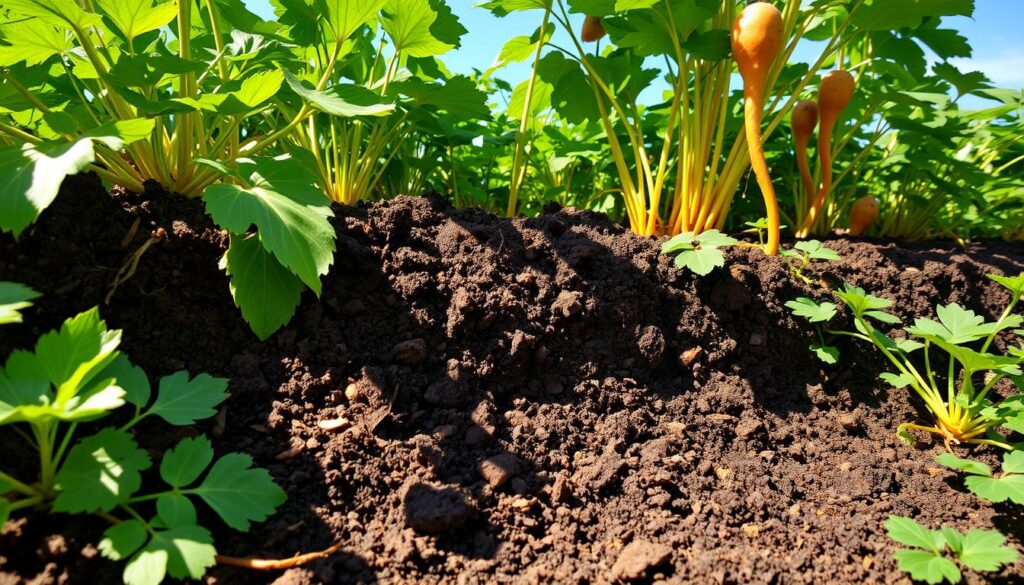
By following these tips and using the best soil for sweet potatoes, you can create an ideal environment for your sweet potato plants to thrive. Remember to also provide your plants with full sun and enough space for the vines to spread out.
Proper Spacing and Support Methods
When growing sweet potatoes, spacing and support are key. Sweet potato vine care helps prevent vines from getting tangled. This can hurt yields and make plants more prone to disease. So, it’s important to give plants enough room.
Rows should be 3-4 feet apart, with plants 12-18 inches apart. This lets air and sunlight reach the plants. Support for vines helps them grow better. You can use trellises, stakes, or other systems for this.
- Wire trellises: These are easy to set up and provide good support for the vines.
- String trellises: These are a good option for smaller gardens and can be easily moved or adjusted as needed.
- Bamboo trellises: These are a natural and eco-friendly option that can add a decorative touch to the garden.
By following these tips, you can get a big harvest of sweet potatoes. Sweet potatoes are ready to harvest after 100-120 days. When the vines turn yellow and the tubers are big, it’s time to pick them. With the right care, you’ll enjoy a successful harvest.
| Row Spacing | Plant Spacing | Trellis Options |
|---|---|---|
| 3-4 feet | 12-18 inches | Wire, string, bamboo |
Water and Fertilization Requirements
When growing sweet potatoes at home, knowing about water and fertilization is key. Sweet potatoes need steady moisture, most in the first weeks after planting. Try to give them 1-2 inches of water each week, either from rain or a hose.
For sweet potato planting tips, here’s a fertilization plan:
- Start with a balanced fertilizer (10-10-10) when you plant
- Use a high-phosphorus fertilizer (10-20-10) when vines spread out
- Don’t overdo it, as too much can make vines weak and long
Sweet potatoes love to eat and need regular food. But, make sure to follow the right amounts to keep their roots safe.
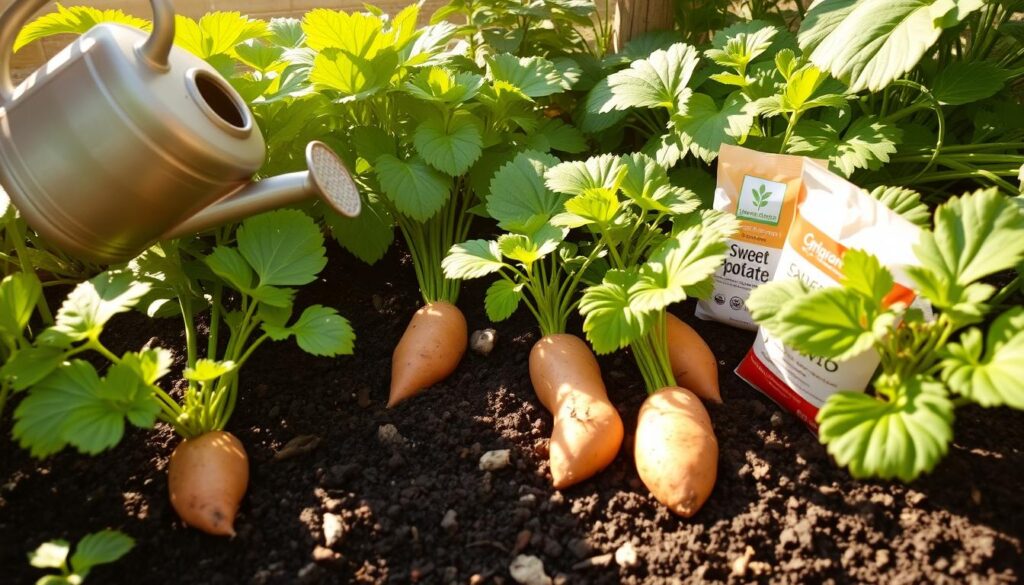
By using these sweet potato planting tips and giving them the right water and food, you’ll grow strong and healthy sweet potatoes at home.
| Fertilizer Type | Application Rate | Timing |
|---|---|---|
| Balanced Fertilizer (10-10-10) | 1-2 pounds per 100 square feet | At planting time |
| High-Phosphorus Fertilizer (10-20-10) | 1-2 pounds per 100 square feet | When vines start to spread |
Managing Sweet Potato Vines
Sweet potato plants grow fast, covering a lot of garden space. To manage them well, you need to take care of their vines. This means regular pruning and training to get more sweet potatoes and make harvesting easier.
Here are some ways to manage sweet potato vines:
- Pruning: Cut off weak or damaged vines to help the plant grow strong and healthy.
- Training: Use a trellis to guide the vines up. This saves space and keeps them from spreading too much.
- Mulching: Put mulch around the plants. It keeps the soil moist, stops weeds, and keeps the temperature right.
Using these methods, you can get a lot of sweet potatoes. Taking good care of the vines is key to a successful harvest. With practice, anyone can grow sweet potatoes well.
For more tips on growing sweet potatoes, check out local gardening advice or online resources. With the right knowledge, you can have a great sweet potato harvest.
| Technique | Benefits |
|---|---|
| Pruning | Promotes healthy growth, prevents disease |
| Training | Maximizes space, reduces spread |
| Mulching | Retains moisture, suppresses weeds, regulates soil temperature |
Common Sweet Potato Pests and Solutions
Sweet potatoes can face many pests, causing damage and lower yields. Knowing common pests and diseases is key. Regular checks and proper storage can prevent these issues.
Aphids, whiteflies, and wireworms are common pests. They harm plants, making tubers less healthy. Natural methods like beneficial insects or organic pesticides can help control them.
Identifying Pest Problems
Spotting pests early is vital. Regularly check plants for damage or infestation. Look for holes, yellow leaves, or eggs and larvae.
Natural Pest Control Methods
There are natural ways to fight pests and diseases. These include:
- Introducing beneficial insects, like ladybugs or lacewings, to control aphids and whiteflies
- Using organic pesticides, such as neem oil or insecticidal soap, for various pests
- Keeping the garden clean by removing weeds and debris to prevent pests
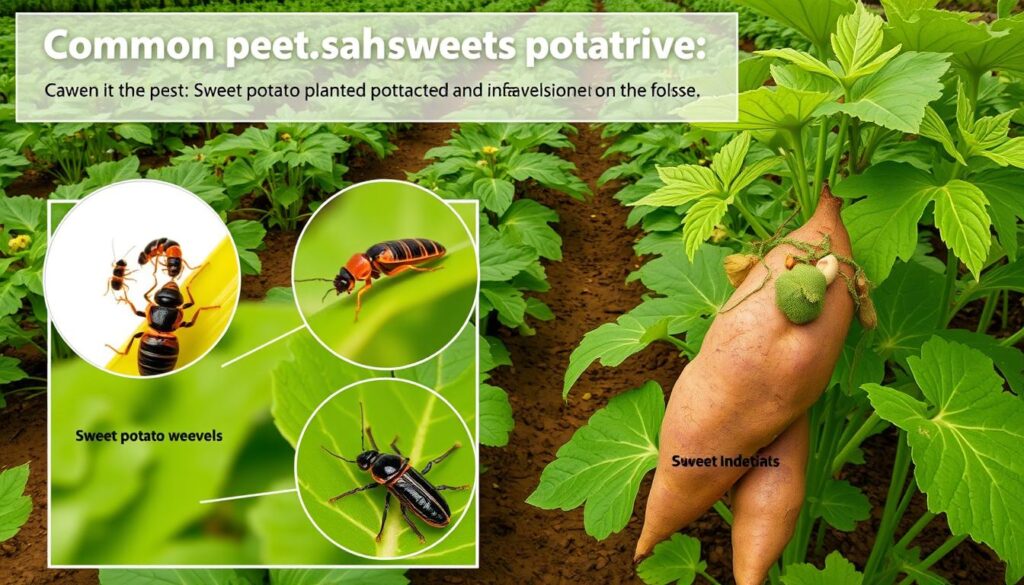
By using these methods, growers can keep pests away and ensure healthy plants. Proper storage also helps keep tubers quality high.
Disease Prevention and Treatment
Growing sweet potatoes at home means knowing about common pests and diseases. These can harm your crop’s yield and quality. It’s key to prevent and treat diseases to protect your sweet potatoes.
Fungal, bacterial, and viral diseases can affect sweet potatoes. Keeping your garden clean is essential. Regularly clean tools and remove sick plants to stop disease spread.
To fight diseases, mix natural and chemical treatments. Neem oil can fight fungal infections. Copper-based fungicides help against bacterial diseases. Also, make sure your plants get enough nutrients. Healthy plants resist disease better.
Here are tips for disease prevention and treatment:
- Regularly check your plants for disease signs
- Remove any sick plants from your garden
- Use natural and chemical treatments for diseases
- Make sure your plants get enough nutrients
By preventing and treating diseases, you can ensure a healthy sweet potato harvest.
Determining Sweet Potato Harvest Time
Harvesting sweet potatoes at the right time is key for the best results. Look for signs like vines turning yellow and dying back. This shows the plants are getting ready to harvest.
To check if they’re ready, gently dig around the plants with a fork. Be careful not to hurt the tubers. Ready sweet potatoes are firm and bright orange. It’s important to harvest them right to keep them safe.
Signs of Maturity
- Vines starting to yellow and die back
- Tubers are firm and have a deep orange color
- Plant tops begin to turn yellow and fall over
After you harvest, it’s important to store the sweet potatoes right. Cure them in a warm, humid place to heal any cuts. Then, store them in a cool, dark spot.
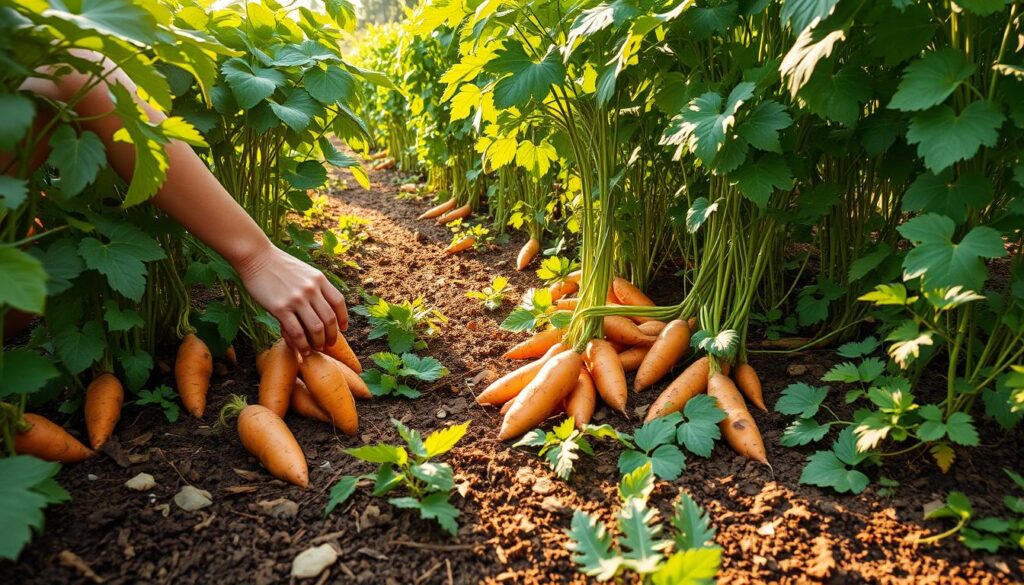
By following these steps, you can enjoy your sweet potatoes for months. Always handle them gently to prevent damage. This helps them last longer.
Post-Harvest Handling Tips
After you harvest your sweet potatoes, it’s key to handle them carefully. This helps keep them in good shape. When you grow sweet potatoes at home, using the right post-harvest handling is vital. A top tip is to clean the sweet potatoes gently to get rid of dirt or debris.
Use a soft-bristled brush or a clean cloth for cleaning. It’s also important to cure the sweet potatoes. This helps heal any wounds and stops rot. To cure, place the sweet potatoes in a warm, humid spot for a few days.
Cleaning Methods
- Use a soft-bristled brush to gently remove dirt and debris
- Wipe the sweet potatoes with a clean, damp cloth
- Avoid using harsh chemicals or abrasive materials that can damage the skin
Curing Process
The curing process is key to keeping sweet potatoes fresh longer. By following these tips and growing sweet potatoes at home, you can enjoy them for months.
| Curing Method | Temperature | Humidity | Duration |
|---|---|---|---|
| Warm water curing | 80-90°F | 80-90% | 30 minutes to 1 hour |
| Air curing | 70-80°F | 60-70% | 2-4 weeks |
By following these tips, your sweet potatoes will stay fresh and healthy longer. These tips are useful whether you’re growing sweet potatoes at home or storing them for later.
Long-Term Storage Solutions
Proper storage is key to enjoying sweet potatoes all year. For sweet potato storage tips, keep them in a cool, dry spot. This keeps them fresh and of high quality. Store them in a basement or root cellar with a temperature of 50-60°F (10-15°C).
Before storing, cure the sweet potatoes. This means keeping them warm and humid for a few days. It heals wounds and dries the skin. Then, store them in a breathable container like a paper bag or mesh bag. Here are more sweet potato storage tips:
- Keep them away from direct sunlight
- Store them in a single layer to prevent moisture buildup
- Check on them regularly to remove any spoiled or rotten sweet potatoes
By following these sweet potato storage tips, you can enjoy your sweet potatoes for months. If you want to learn more about How to Grow Sweet Potatoes, check out our previous sections for a detailed guide.
With the right storage and care, you can enjoy your sweet potatoes all year. This way, you’ll make the most of your harvest.
| Storage Method | Temperature | Humidity |
|---|---|---|
| Basement or root cellar | 50-60°F (10-15°C) | 80-90% |
| Paper bag or mesh bag | 50-60°F (10-15°C) | 60-70% |
Conclusion: Growing Sweet Potato Success
Growing your own sweet potatoes can be very rewarding. By following the steps in this guide, you’ll get a great harvest. Start with good sweet potato slips, prepare the soil well, and give your plants the right conditions.
Keep an eye out for pests and diseases as you grow your sweet potatoes. Use natural, organic ways to fight them off. Learn how to harvest and store your sweet potatoes to keep them fresh and tasty for a long time.
With a bit of patience and care, you can grow your own sweet potatoes at home. They’re nutritious and delicious. So, why not try it? Start planning your sweet potato garden today and enjoy the fruits of your labor.
FAQ
What are the different types of sweet potatoes?
Sweet potatoes come in many varieties, like ‘Beauregard’, ‘Jewel’, ‘Garnet’, and ‘Murasaki’. Each variety has its own look, feel, and taste.
What are the ideal climate requirements for growing sweet potatoes?
Sweet potatoes love warm, frost-free weather and well-drained soil. They need 90-120 days of growing with temperatures between 65-85°F.
What are the benefits of growing your own sweet potatoes?
Growing sweet potatoes at home means fresh, healthy food that’s cheaper. Plus, they taste and feel better than store-bought ones.
What tools and materials are needed to grow sweet potatoes?
You’ll need a garden fork, hoe, trowel, and pruning shears. Start with sweet potato slips, compost, and fertilizer. You might also need sand or perlite for the soil.
How do I select and prepare sweet potato slips for planting?
Pick healthy slips with strong roots. Trim any bad leaves or stems and make sure they’re wet before planting.
How do I properly plant and care for sweet potato vines?
Plant slips in rich, well-drained soil, about 12-18 inches apart. Keep the soil moist and fertilize every 4-6 weeks. Prune vines to help them grow and stay healthy.
What are the best soil conditions for growing sweet potatoes?
Sweet potatoes like slightly acidic soil (pH 5.8-6.5) with lots of organic matter. The soil should drain well to let the tubers grow.
How do I properly space and support the sweet potato vines?
Plant slips in rows 3-4 feet apart, with 12-18 inches between each. Use a trellis to keep vines off the ground and improve air flow.
How do I manage common sweet potato pests and diseases?
Deal with pests and diseases quickly. Use natural methods or organic pesticides. Prevent problems with crop rotation and keeping the area clean.
When is the best time to harvest sweet potatoes?
Harvest sweet potatoes 90-120 days after planting, when leaves and vines turn yellow. Dig carefully to avoid damaging the tubers.
How do I properly store and preserve sweet potatoes?
Cure sweet potatoes in a warm, airy spot for 10-14 days. Then, store them in a cool, dry place with good air flow. Avoid refrigeration to keep them fresh.
Share this post: on Twitter on Facebook

